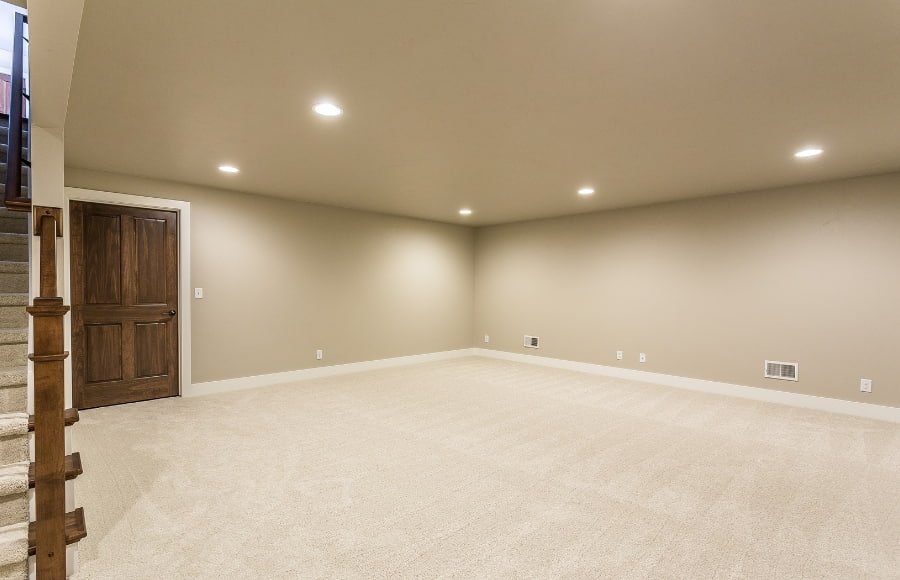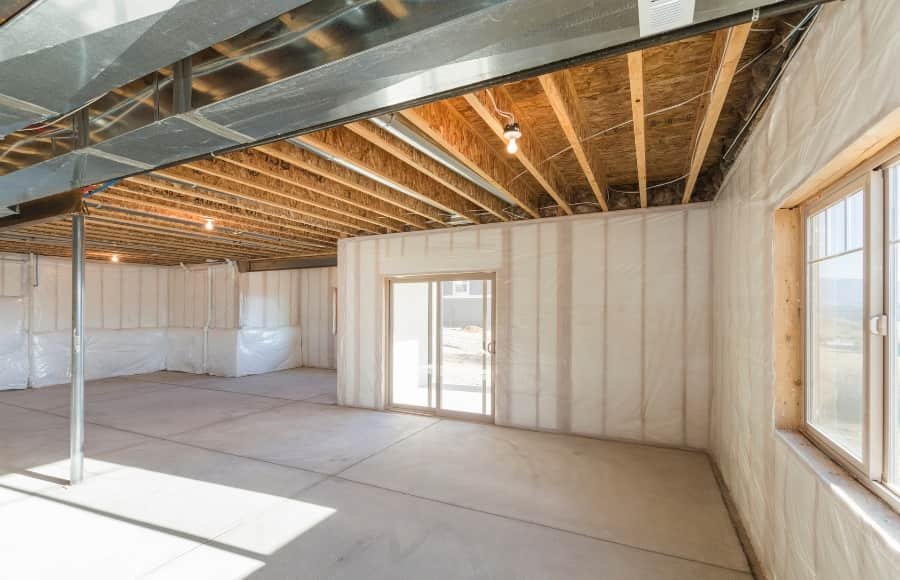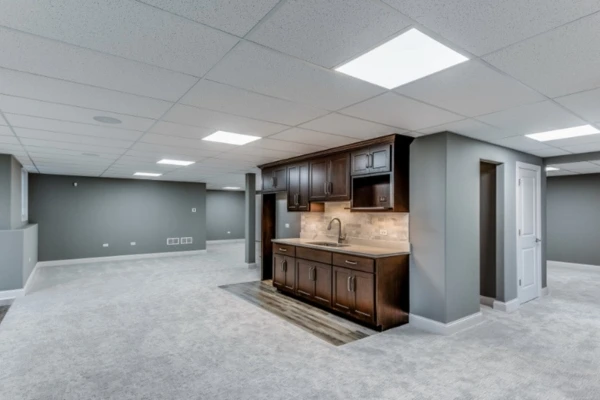What Is Considered a Finished Basement?
Understanding what constitutes a basement finishing NJ, is essential for homeowners considering renovations. This classification affects property value and usability, particularly as small basement renovations become more popular. The criteria for a finished basement include proper heating, flooring, and wall finishes. Exploring these requirements helps clarify the differences between finished and partially finished basements.
Defining a Finished Basement

Understanding the definition of a finished basement is essential for homeowners considering renovations or improvements. This section outlines the key criteria and common misconceptions associated with finished basements.
Criteria for a Finished Basement
A finished basement must meet specific standards to qualify as usable living space. Key criteria include:
- Permanently installed heating and cooling systems that integrate with the home’s utilities.
- Complete flooring solutions, such as hardwood, tile, or carpet, covering all floor areas.
- Regulated ceiling heights, typically a minimum of 7 feet, to ensure comfort and usability.
- Insulated and framed walls finished with drywall, providing a polished look and energy efficiency.
- Electrical and plumbing systems that support additional appliances and fixtures, enhancing functionality.
Finished vs. Partially Finished Basements
Understanding the difference between finished and partially finished basements helps in assessing the viability of a renovation project. Finished basements are completely outfitted with amenities and structural elements that create a livable environment. In contrast, partially finished basements may include some upgraded features but still lack essential elements, such as:
- Heating and cooling systems that are not integrated with the home.
- Incomplete flooring or unfinished walls, which can impede usability.
- Inadequate lighting and electrical outlets for a true living experience.
Common Misconceptions
Several myths surround the concept of finished basements. Clarity is important to avoid misunderstandings:
- Not all basements with carpet or furniture are considered finished.
- External access through a bulkhead or exterior door does not qualify as acceptable access.
- Temporary heating solutions, like space heaters, disqualify a basement from being labeled finished.
Finished Basements and Tax Implications

Understanding the tax implications of finished basements is crucial for homeowners. A finished basement may influence property taxes and the overall financial landscape surrounding homeownership.
What is Considered a Finished Basement for Tax Purposes
For tax purposes, a finished basement typically refers to a space that is fully developed and includes necessary amenities that add to the property’s livable area. This includes features such as:
- Permanently installed heating and cooling systems
- Appropriate flooring, such as tile or carpet
- Functional electrical and plumbing systems
- Egress windows for safety, particularly if it includes a bedroom
When assessed for property taxes, a finished basement is often treated as additional square footage, which can increase the property’s assessed value. This is important during tax assessments and when determining potential resale value.
Local Codes and Regulations
Every locality has its codes and regulations pertaining to residential construction. Homeowners should adhere to local building codes when finishing a basement, which may include:
- Obtaining necessary permits to ensure compliance
- Adhering to safety standards, especially concerning egress and ventilation
- Ensuring that electrical and plumbing installations meet code, which might affect the finished classification
Failure to comply with local regulations can result in fines or complications during future property sales. Therefore, understanding the legal framework around finished basements contributes to informed decision-making and financial planning.
Finished basements offer valuable additional living space within a home. They can enhance both functionality and comfort while increasing property value.
Finished Basements as Living Space
Is a Finished Basement Considered Living Space?
A finished basement can be classified as living space under certain conditions. It needs to meet local regulations which typically consider factors such as ceiling height, ventilation, and amenities. When properly completed, it can serve various purposes, such as a guest room, home office, or recreational area, contributing significantly to the livability of a home.
Legal and Safety Considerations
Understanding the legal and safety implications of finished basements is essential for homeowners aiming to convert this area into livable space. Compliance with local housing codes is crucial for ensuring safety and determining usability.
Egress and Accessibility
Basements intended for living purposes must include an egress window or a door that meets safety standards. This ensures proper exit routes in emergencies. In addition, permanent internal stairs leading to the main living areas must be established to facilitate easy access.
Heating and Cooling Requirements
For a basement to function effectively as living space, it requires a permanent heating and cooling system. This means connecting to the home’s existing HVAC system rather than using temporary solutions like space heaters or window units. Proper climate control contributes to comfort and livability.
Essential Features of a Finished Basement
Maximize space with a Finished Basement incorporating essential features that make it comfortable and functional, transforming it into an inviting living space. Key elements include flooring, wall and ceiling finishes, and installed systems that enhance usability and compliance with local codes.
Flooring Options for Finished Basements
Choosing the right flooring is vital for both aesthetics and practicality. Popular options include:
- Carpet: Provides warmth and comfort, ideal for entertainment areas.
- Tile: Durable and moisture-resistant, perfect for areas prone to humidity.
- Laminate: Offers a wood-like appearance at a lower cost and is easy to maintain.
- Vinyl: Versatile and available in various designs, resistant to moisture damage.
Wall and Ceiling Finishes
The walls and ceilings of a finished basement should contribute to a polished look. This includes:
Drywall vs. Painted Concrete
Drywall is the preferred choice for finished basements as it provides better insulation and a smoother finish, promoting a more comforting environment. Conversely, painted concrete may be a cost-effective option but lacks the warmth and texture of drywall.
Ceiling Height Standards
A finished basement should have a ceiling height that meets local building codes, typically at least 7 feet. Higher ceilings can enhance the feeling of space and openness, making the area more appealing.
Installed Systems
Properly installed systems are crucial to ensure year-round comfort and functionality.
Permanently Installed Heating and Cooling
A finished basement must include an HVAC system that is permanently installed, tailored to circulate air effectively. This avoids reliance on portable units, which are not suitable for long-term living spaces.
Electrical and Plumbing Installations
A comprehensive electrical system with sufficient outlets and lighting fixtures is essential. If a kitchenette or bathroom is present, proper plumbing installations must also be in place to ensure functionality and compliance with health regulations.
Navigating Small Basement Renovations
Small basement renovations can transform underutilized spaces into functional areas of the home. Proper planning is essential to maximize efficiency and return on investment while ensuring compliance with local regulations.
Maximizing Space and Functionality
Effective small basement renovations involve creative design choices that enhance usability without overwhelming the limited space. Some strategies include:
- Utilizing open floor plans to create an airy feel.
- Incorporating multifunctional furniture that can be easily moved or adapted.
- Using vertical storage solutions to free up floor space.
- Installing built-in shelving or cabinets to provide storage without encroaching on living space.
Cost Considerations and ROI
When planning a small basement renovation, understanding the financial implications is crucial. Homeowners should consider both initial costs and potential returns.
Budgeting for Finishing
Setting a realistic budget is essential. Costs can vary significantly based on:
- Local labor rates.
- Quality of materials selected.
- Scope of the renovation project.
- Potential unexpected costs, such as water damage or structural repairs.
Long-term Value
Investing in a well-finished basement may enhance the overall property value. Considerations for long-term value include:
- Adding functional living space that appeals to potential buyers.
- Increased marketability due to modern amenities.
- Recovering a significant portion of renovation costs upon resale.
Real Estate and Market Implications
The real estate market places significant value on finished basements. These enhancements can alter a property’s appeal to potential buyers and influence market trends in various neighborhoods.
Impact on Home Value
A finished basement can serve as a strong selling point for a home. Properties with this additional living space often command higher offers due to the increased square footage. Key factors contributing to this enhanced value include:
- Increased livable area that can be utilized for various functions.
- Potential for rental income if the basement is converted into a separate unit.
- Attraction to families looking for extra rooms, such as bedrooms or playrooms.
Common Market Expectations
In the current real estate landscape, buyers have clear expectations concerning finished basements. Understanding these expectations is crucial for homeowners contemplating renovations. Factors influencing what buyers look for include:
- Well-defined spaces that blend seamlessly with the home’s overall design.
- Properly installed heating and cooling systems that ensure year-round comfort.
- Compliance with safety regulations, including egress windows for bedrooms.
In many markets, a finished basement is viewed not merely as a bonus but as a necessity. This viewpoint underscores the importance of adhering to legal standards during the renovation process.
Frequently asked questions can provide valuable insights into the nuances of finished basements. You can also ask your basement Finishing contractor these questions.
FAQs About Finished Basements
Common Questions from Homeowners
Homeowners often have several questions regarding finished basements. Some of the most common inquiries include:
- What constitutes a legal finished basement?
- How do I ensure my basement complies with local building codes?
- Are permits required for basement renovations?
- Can I use my basement for rental purposes?
- What features should I prioritize when finishing my basement?
Understanding these aspects helps in making informed decisions regarding renovations.
Addressing Buyer Concerns
When it comes to finished basements, potential buyers often have specific concerns. Clarifying these can aid the selling process:
- Is the basement safe and compliant with safety standards?
- What kind of insulation and ventilation is in place?
- Are there any signs of water damage or flooding?
- What heating and cooling systems are installed?
- Is there adequate egress in case of emergencies?
Addressing these concerns effectively can enhance buyer confidence and facilitate smoother transactions.



